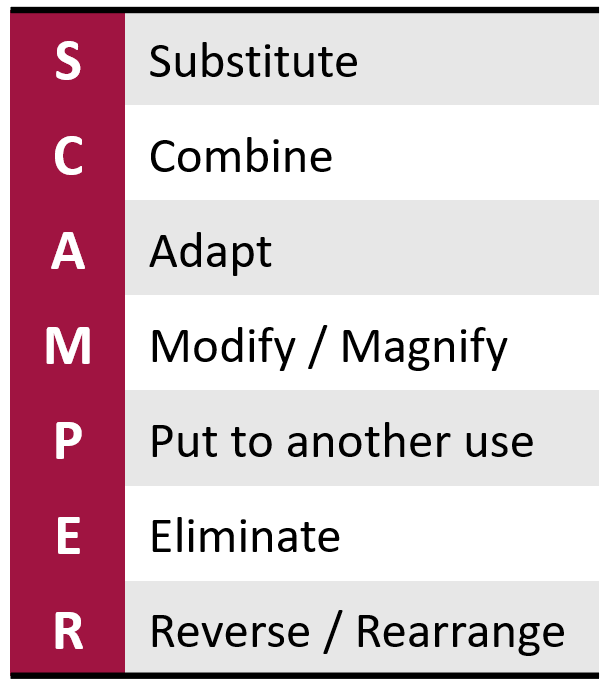Appearance
SCAMPER Method
- Subject
- Delivering business and customer value/Product development
- Participants
- The entire team, stakeholders
- Facilitator
- Agile Coach / Agile Master

Summary
SCAMPER is a creativity technique that generates ideas with seven specific requests to vary an initial configuration.
Definition
This method is used to generate ideas, for example in brainstorming. It is based on the assumption that all new discoveries are modifications of something that already exists. SCAMPER is an acronym that stands for:
substitute, combine, adapt, modify, put to another use, eliminate, reverse.
It was developed by Bob Eberle.
Motivation
SCAMPER is useful when products, services, strategies or processes need to be optimized or redesigned.
Results
A collection of ideas and approaches emerges from this method.
Benefit
The pre-defined questions structure the brainstorming process, making it more efficient than unstructured brainstorming. The method helps to find new solutions by looking at existing facts in a new and closer way and by consciously changing previous arrangements or patterns. SCAMPER can uncover barriers and limitations in the organization and thus identify new opportunities. It is simple and requires no prior preparation.
Procedure
A facilitator leads the participants through the seven categories and encourages them to abandon established thought patterns and look at existing issues from a different perspective. Formulate clearly what you want to achieve with the SCAMPER session and make the question visible to everyone, e.g., on a flipchart or whiteboard. Good starting points are existing products or processes that either need to be improved or that cause problems. The facilitator considers all seven areas together with the group. For an orderly process, it is beneficial to go through the questions one after the other in the first step. Ask the prepared questions and visualize the answers on cards or directly on a flipchart or whiteboard:
Substitute: Which parts of the idea or product can you substitute?
Combine: Can parts or the whole be combined with other things?
Adapt: How could you take elements from other areas, adapt them and incorporate them into the idea? Or are there market developments, such as the desire for different form factors, that we can adapt to?
Modify/Magnify: What could be magnified or emphasized? Increase or decrease size, scale or scalability, change shape or vary attributes such as color, haptic or acoustics.
Put to another use: For what other purposes can the idea be used?
Eliminate: What could be reduced or omitted?
Rearrange/Reverse: Could the arrangement and/or order of the parts of my idea be changed? What if parts or the whole were reversed? Turn the inside out, upside down or find an opposite use.
Once you have a sufficient number of ideas, you can structure them using mind maps or lists. Combine similar ideas, e.g. all ideas related to a specific function of the product. Participants then rank their ideas according to their feasibility, cost, time horizon (or whatever criteria suits them) and prioritize them if necessary. These steps can be done immediately or in a separate step, depending on the size of the group and the scope of the ideas.
Tools
Whiteboard/flipchart, sticky notes
Hints
As with brainstorming in general, all ideas should be mentioned directly and not evaluated first. If possible, all questions should be answered, i.e. good time management is essential in this method to avoid getting stuck on one question.
See also
Andrea Windolph (2017): "SCAMPER", projektmagazin.de